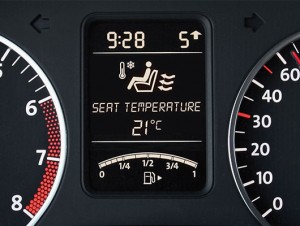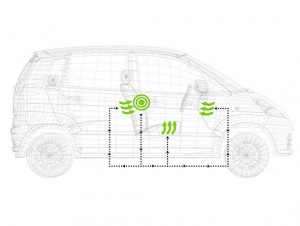My first guest article
Here is the very first guest article on Moir’s Moisture Matters blog. It is reproduced below by kind permission from Sensirion, an innovative Swiss company that I’ve known for many years and had the pleasure of visiting over ten years ago. They gave me a present of a small temperature and humidity measuring device that I used to take with me to my early moisture interaction talks and pass around my audience. My point was that our bodies are much more sensitive to temperature than humidity changes. Most of the time you simply cannot guess the humidity and so are unaware that a change has happened and therefore have no feel or warning of its impact on the things around you. An area where this is important and even critical is handling and working with materials that react to moisture, which is the main topic of my talks.
By some strange quirky coincidence, my first guest article from Sensirion talks about temperature and humidity control in vehicles and at my first school talk the teacher told me that he used the misting up of windows when travelling in a car as a way of introducing the students to humidity. Recently Sensirion have released the world’s smallest humidity and temperature sensor and I mean really small. Their article below talks about how these sensors go way beyond just measuring humidity and are integrated into rapid feedback systems to make the vehicle’s environment more comfortable for the driver and passengers.
From multizone air conditioning to door locks, more and more vehicle functions are becoming automated. Sensirion is driving innovation in this field and developing automatic climate control for vehicle seats. The latest humidity and temperature sensors make this possible and set new standards in terms of comfort, safety and energy consumption.

Car seat temperature control
Adjusting the temperature is often one of the first things you do when you get into a vehicle. Whether it’s too hot or too cold outside, you want the climate in the car to be exactly how you like it. But of course, you don’t notice you’re hot or cold until it’s too late – and then you’re either sweating or freezing. It could be said, then, that humans leave a little to be desired when it comes to regulating the interior climate. And it’s no different with vehicle seats equipped with ventilation systems – air-conditioned seating, in other words. The seat surface and backrest can be cooled via the seat climate control function. Optimal ventilation is provided by fans that pump air through the seat, making it possible to adjust the temperature of the seat at will. Humidity and heat are dissipated through air channels in the seat cushions, enabling passengers to stay cool and creating a pleasantly balanced seat temperature. Until now, it has only been possible to control such ventilation systems manually. And, as with air conditioning, the human at the controls does not tend to notice the temperature until it is too late. When you’re on the road for a lengthy spell in particular, turning on the climate control too late or leaving it active for too long can easily make the seat surface far less comfortable than it ought to be. The solution is automatic climate control in the vehicle seat. Until now, sensor technology had not yet reached the stage of advancement allowing a sensor to quickly and accurately measure temperature and humidity while being small enough that the passenger would not consider it distracting. Sensirion has now developed the missing key element.
Automatic climate control in vehicle seats continuously measures the humidity and temperature on the seat surface and backrest, thereby automatically controlling seat heating and ventilation. Multiple sensors integrated in the vehicle seat supply the data required for the automatic control function, ensuring that individualized climate control remains within a predefined comfort range. Manually switching the system on or off or even readjusting it becomes unnecessary – integrated humidity and temperature sensors take care of this. The automatic control function keeps the air-conditioned seat within the comfort range. With manual control, the seat temperature is only adjusted when it no longer falls within the comfort zone. Automatic control of air-conditioned seats therefore increases passenger comfort.
Technical implementation
The latest generation of ultra-compact sensors guarantee extremely short reaction times in measuring humidity and temperature. Measuring just a few millimeters in size, the sensors can be easily integrated into the seat structure. They measure directly at the point of contact with the vehicle occupant, thereby enabling seat ventilation and seat heating to be continuously controlled.

Air circulation in a car
The latest generation of sensors are exceptionally effective, measuring the humidity and temperature directly on the seat surface (either through perforated leather or fabric upholstery). The data collected by the sensors forms the basis for a control cycle in which the seat heating and seat ventilation are automatically and continuously controlled. Additional process optimization measures such as the inclusion of parameters from the air-conditioning system further enhance passenger comfort. Feeding the measurement data from the seat sensors into the climate control system as a whole also enhances efficiency. If the temperature and humidity on the seat surface are within the comfort range, the air-conditioning system does not have to cool or heat the air as much, because the optimally air-conditioned seat provides the same level of comfort. This even applies in situations where the air-conditioning system would usually increase its output due to the ambient temperature or humidity.
Sensirion has been providing the automotive market with comprehensive sensor solutions for many years. It is now using its experience in the physical variables of humidity and temperature to optimize comfort and safety in motor vehicles while reducing energy consumption. Earlier generations of sensors by Sensirion have found extensive use in vehicle climate control systems. In the field of “antifogging applications”, for example, Sensirion is the global market leader. The company is accustomed to dealing with large order volumes and high quality demands. The fact that automatic climate control in vehicle seats is not simply a pipe dream has been underscored by successful early trials.
Promising lab results
Sensirion conducted various trials with the automatic air-conditioned seat. The results were impressive. Testing focused on various sensor measurement positions. The reaction time, package and integration in a series product were assessed according to the location of the sensor in the seat. If the sensors are correctly positioned, they measure the actual temperature and humidity conditions on the seat surface. The data is then processed by a software program, which in turn controls the seat’s air-conditioning system and either ventilates or heats it.
Under extreme conditions, the sensor technology and control software can significantly improve the seat temperature at a rapid pace. In a range of test situations, the integrated sensors made it possible to determine the reference value for a pleasant seat surface temperature as quickly as possible. The seat ventilation or heating can then be activated to bring the seat surface temperature to within the approximate vicinity of the reference value in the minimum amount of time. If the humidity and temperature conditions in the vehicle’s interior change – for instance by using the air-conditioning system or opening the window – the climate control for the vehicle seat automatically adjusts the temperature within seconds.
The evolution of humidity and temperature sensor technology
Sensirion set the first sensor technology milestone over a decade ago with the world’s first digital, fully calibrated humidity and temperature sensor. It revolutionized the sensor market of the day. From then on it was much easier and required much less expertise from the customer to install sensors such as this. CMOSens® formed the basis for this revolution. The technology enabled the sensor element to be fused with analog and digital processing electronics on a tiny CMOS silicon chip. Some four years ago, engineers at Sensirion developed the world’s smallest humidity and temperature sensor, the SHT2x. Since then, millions of these sensors have been used in the automotive sector. In 2012, Sensirion set new benchmarks yet again in terms of size, energy consumption, unit quantities and price. The new sensor was the smallest in its class worldwide. And the bar was recently raised once again for humidity and temperature sensors with the launch of the first chip-scale package sensor.
Comfort, safety and energy savings
Automatic climate control for vehicle seats is more than just a gimmick. It enhances the comfort level for passengers, which is especially important on long journeys. Truck drivers and other long-distance drivers are especially dependent on having an interior climate tailored to their needs. Moreover, regulated seat heating also enhances safety by making it unnecessary for the driver to manually readjust the system – they are not distracted by having to change the settings and can concentrate entirely on driving. In all, then, vehicles that feature automatic climate control in the vehicle seat provide greater driving comfort, enhanced safety and lower energy consumption. From Sensirion’s perspective, there is now nothing to stop automatic climate control from becoming a staple of vehicle seats.

Leave a Reply